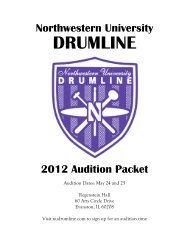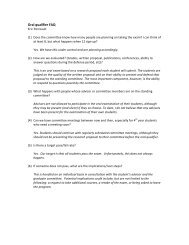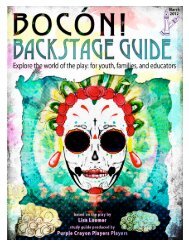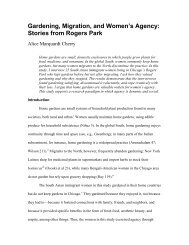research - Associated Student Government, Northwestern University
research - Associated Student Government, Northwestern University
research - Associated Student Government, Northwestern University
You also want an ePaper? Increase the reach of your titles
YUMPU automatically turns print PDFs into web optimized ePapers that Google loves.
RESEARCHThough Shelley expresses much grief toward the deathof his friend, at the end of the poem he no longer viewsdeath as a fixed ending of human existence, but rather asa path to spiritual transcendence, achieving a new meaningof death that, as we shall see, Thomas denies in hispoetry. The speaker avers:[…] keep thy heart light lest it make thee sinkWhen hope has kindled hope, and lured thee to the brink.Or go to Rome, which is the sepulcherOh, not of him, but of our joy: ’tis noughtThat ages, empires, and religions thereLie buried in the ravage they have wrought […]he is gathered to the kings of thoughtWho waged contention with their time’s decay,And of the past are all that cannot pass away. (ll. 422-32)Diverging from the despondent nature at the beginningof Adonais, Shelley’s speaker directs these lines tothe mourners of Keats’ death, instructing them not tomourn ceaselessly over him, but rather to maintain positivity,to “keep thy heart light.” When grief overpowersthem, he tells them to go to Rome, where Keats is buried,and to marvel at him and all of the other powerful mindswho are buried there, the people of various “ages,” “empires,”and “religions.” Although they are gone from theearth now, the speaker tells the mourners not to thinkof them as such, but rather to view the dead as eternal,“wag[ing] contention with their time’s decay.” In otherwords, death serves to monumentalize the deceased,for though their bodies may physically be gone, deathserves as a vehicle for us to honor them forever andhold fast to their timeless ideas within the confines ofour minds—within the memories that we have of them.Shelley asserts that through memory, the spirits of thedead remain glorified within us, preventing them fromever truly dying:The breath whose might I have invoked in songDescends on me; my spirit’s bark is drivenFar from the shore, far from the trembling throngWhose sails were never to the tempest given;The massy earth and spherèd skies are riven!I am borne darkly, fearfully, afar;Whilst burning through the inmost veil of Heaven,The soul of Adonais, like a star,Beacons from the abode where the Eternal are. (ll. 487-495)As Shelley’s speaker is composing the poem, thespirit of Keats apparently is descending upon him, andhe is captivated by the thought. He describes rememberinghis friend’s presence as being on a journey thatdrives him “far from the shore, far from the tremblingthrong.” The speaker epitomizes this idea through thefinal lines of the poem, describing Keats’ spiritual presencein his mind as being illuminating, “like a star,” nevertruly gone from being, but rather “beacons from theabode where the Eternal are.” In this way, he glorifies thedeath of his friend, conceptualizing death as a continuationof life. While Thomas explains death in a linearfashion, as a marked and finite ending to human life,Shelley does not grant death this power. As his speakerVOLUME 7, 2011-2012avers, death is not the ending of a rigid existence thatbegins with birth and ends with death, but rather theintermediary to a more glorified existence, for throughdeath, we remember the lives of the deceased, monumentalizingthem within the mind.4. Thomas as Neo-RomanticAlthough Wordsworth, Keats, and Shelley were allforced to confront the horrors and grief of death, theyultimately accepted it and reinterpreted it, leading toan eventual attaining of solace. Indeed, though in quitedifferent ways, each of these Romantics asserted thathumans can triumph over death and reach a sense ofthe infinite. This conceptualization of death, however,is one that Thomas resists entirely, viewing death as anultimate ending with no possibility for reappraisal. In“Fern Hill,” one of Thomas’s most prominent poems,he reflects on the extreme sorrow of human existence,for though we are initially enthralled in the temporaryjoys of life during our youth, ultimately death destroysall of us. Throughout most of the poem, Thomas reflectson the beauty and gloriousness of his days of hisyouth, employing rich imagery to characterize his idyllicexperiences running along the fields of “Fern Hill.” Hewrites,Now as I was young and easy under the apple boughsAbout the lilting house and happy as the grass was green […]And honored among wagons I was prince of the apple townsAnd once below a time I lordly had the trees and leavesTrail with daisies and barleyDown the rivers of the windfall light. (Thomas ll. 1-9)Rich imagery abounds in the first stanza of thepoem, as Thomas reflects nostalgically on his childhood.He describes his past self as a royal, majestic figure,“prince of the apple towns” and “honored” by everyoneand everything in the natural scene surroundinghim. Though such comparisons are clearly hyperbolic,as Thomas was only a child at the time, through depictinghis childhood experience in such a grandiose andelevated manner, he portrays the fond emotions of hisseemingly perfect upbringing. Imagery of the naturalbeauty surrounding him is ubiquitous in the first stanza,notably the richness of the “apple boughs,” the “trailwith daisies and barley,” and the “rivers of the windfalllight.” Indeed, throughout the first half of the poem,Thomas associates youth with happiness, remarkingthat he was in fact both “green and golden” during thedays of his childhood in Fern Hill (15).Thomas’s limitless bliss during his youthful years isalso reflected in the pace of the poem at the beginning.During the sections in which the speaker describes thejubilant days of boyhood, the poem moves incrediblyquickly through the use of enjambment, letting eachverse flow into the next, as opposed to pausing throughthe use of punctuation. For example, Thomas writes:“All the sun long it was running, it was lovely, the hay/Fields high as the house, the tunes from the chimneys, itNORTHWESTERN UNDERGRADUATE RESEARCH JOURNAL31











